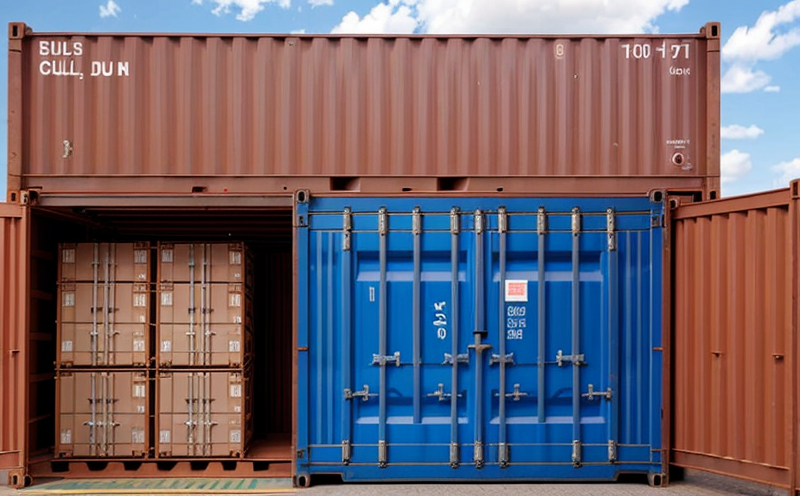USP Transport Simulation Packaging Testing
The United States Pharmacopeia (USP) transport simulation packaging testing is a critical method used in pharmaceutical development and quality assurance to ensure that drug products maintain their stability, integrity, and efficacy during transit. This service is pivotal for compliance with international standards such as USP and . The primary objective of this test is to evaluate how well packaging materials and container closure systems protect the product from environmental stressors like temperature, humidity, light, and mechanical shock.
The test involves simulating real-world conditions that a drug package may encounter during transportation. This includes exposure to various temperatures, humidity levels, vibrations, and static pressures that can affect the stability of pharmaceutical products. The goal is to identify potential weaknesses in the packaging that could lead to degradation or contamination of the product.
For this testing, we employ advanced equipment capable of replicating the harsh environmental conditions faced during transport. Our facilities are equipped with climate chambers that can control temperature and humidity, shaker tables for simulating vibrations, and other specialized instruments designed to replicate various stressors. Samples undergo rigorous testing under controlled conditions to ensure accuracy.
The process begins with selecting appropriate samples based on the specifications provided by our clients. These could include bottles, blisters, vials, or any other container closure systems used in pharmaceutical packaging. Once selected, these containers are filled with either a simulated product (such as a solution) or an inert substance that mimics the physical properties of the actual drug.
After filling, each sample undergoes exposure to controlled environmental conditions designed to mimic typical transport scenarios. For instance, temperature cycling between extreme cold and heat is common for many pharmaceuticals, especially those sensitive to temperature fluctuations. Additionally, humidity levels are adjusted to represent different geographical regions where the product might be shipped.
Following the exposure period, we carefully examine each sample for signs of degradation or contamination. This includes visual inspection for any physical changes like discoloration or cracks, as well as more sophisticated methods such as chromatography or other analytical techniques if required by specific regulatory requirements. Compliance with USP standards ensures that only packages meeting strict criteria proceed to market.
Our laboratory adheres strictly to industry best practices and international guidelines when conducting these tests. We utilize cutting-edge technology and methodologies recommended by organizations like the International Organization for Standardization (ISO), American Society for Testing and Materials (ASTM), European Pharmacopoeia (Ph. Eur.), and others. Compliance with these standards not only enhances product quality but also streamlines regulatory approval processes.
In summary, USP transport simulation packaging testing is an essential step in ensuring that pharmaceutical products remain safe, effective, and reliable throughout their shelf life. By providing accurate data on the performance of container closure systems under various stress conditions, we help manufacturers make informed decisions about their packaging design, materials selection, and overall quality assurance practices.
Applied Standards
The testing adheres to strict guidelines outlined in USP , which deals with the compatibility of container closure systems for parenteral drug products. Additionally, we follow USP , which provides requirements and recommendations for packaging design evaluation.
These standards emphasize the importance of selecting appropriate materials and designs that ensure adequate protection against factors like moisture ingress, gas permeation, mechanical impact, and microbiological contamination. By adhering to these guidelines, we ensure that our testing results are reliable and can be trusted by regulatory bodies around the world.
Our laboratory is equipped with state-of-the-art facilities capable of simulating a wide range of environmental conditions specified in USP standards. This includes controlled temperature ranges from sub-zero temperatures up to high-heat environments, humidity levels spanning dry desert conditions to tropical rainforest settings, and exposure times that span from hours to days depending on the product's sensitivity.
Through our adherence to these rigorous protocols, we provide clients with comprehensive insights into how their packaging solutions perform under diverse environmental stresses. This information is invaluable for optimizing product performance and ensuring compliance with regulatory requirements.
Industry Applications
| Application | Description |
|---|---|
| Parenteral Drug Products | This includes injectable medications like insulin, vaccines, and other sterile solutions. Ensuring proper protection during transport is crucial to maintain sterility. |
| Inhaled Medications | Products such as inhalers need robust packaging that can withstand jostling without compromising the delivery of medication. |
| Oral Solid Dosage Forms | Tabs, capsules, and similar formulations may suffer from moisture damage if not adequately protected during shipment. |
| Topical Medications | Ointments, creams, and other topical treatments can degrade due to exposure to sunlight or temperature changes. |
| Vaccine Products | The fragile nature of vaccines makes them particularly sensitive to transportation stresses. Proper packaging is vital for maintaining potency. |
| Biopharmaceuticals | These complex molecules require specialized packaging that can shield them from environmental influences. |
Quality and Reliability Assurance
The quality of pharmaceutical products is paramount, and ensuring reliable performance during transport is a key component of this. Our laboratory employs stringent quality control measures to maintain high standards throughout the testing process.
We start by meticulously calibrating all equipment used in the tests to ensure precision and accuracy. Each sample undergoes multiple rounds of testing to account for variability, and results are cross-verified using additional analytical methods where necessary.
Our team of experts conducts thorough analysis of each dataset generated from the tests, paying close attention to any anomalies or outliers that might indicate issues with the packaging materials or design. Any discrepancies found during these analyses are documented and reported back to clients for further investigation if needed.
The robustness of our quality assurance process extends beyond just technical aspects; it also encompasses adherence to ethical standards and continuous improvement practices. Regular audits by independent third parties help us stay compliant with all relevant regulations while fostering innovation within our laboratory operations.





